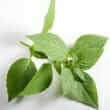Background
- Sweet basil (Ocimum basilicum) is a commonly used spice. The constituent estragole is naturally found in sweet basil and is used in fragrances and flavorings. Although laboratory study has found that estragole may be associated with cancer, human study is lacking.
- Laboratory studies have investigated sweet basil for its antiviral, anticancer, and antibacterial effects. However, currently, there is not enough evidence in humans to support the use of sweet basil for any indication.
References
- Chiang LC, Ng LT, Cheng PW, et al. Antiviral activities of extracts and selected pure constituents of Ocimum basilicum. Clin Exp.Pharmacol.Physiol 2005;32(10):811-816.
View Abstract - Erler F, Ulug I, Yalcinkaya B. Repellent activity of five essential oils against Culex pipiens. Fitoterapia 2006;77(7-8):491-494.
View Abstract - Esiyok D, Otles S, Akcicek E. Herbs as a food source in Turkey. Asian Pac.J Cancer Prev. 2004;5(3):334-339.
View Abstract - Hoang LM, Fyfe M, Ong C, et al. Outbreak of cyclosporiasis in British Columbia associated with imported Thai basil. Epidemiol.Infect. 2005;133(1):23-27.
View Abstract - Hsu WY, Simonne A, Jitareerat P. Fates of seeded Escherichia coli O157:H7 and Salmonella on selected fresh culinary herbs during refrigerated storage. J Food Prot. 2006;69(8):1997-2001.
View Abstract - Imoberdorf R, Ruhlin M, Ballmer PE. [Eating and drinking during aging]. Ther Umsch. 2005;62(12):847-851.
View Abstract - Iten F, Saller R. [Fennel tea: risk assessment of the phytogenic monosubstance estragole in comparison to the natural multicomponent mixture]. Forsch.Komplementarmed.Klass.Naturheilkd. 2004;11(2):104-108.
View Abstract - Lalko J, Api AM. Investigation of the dermal sensitization potential of various essential oils in the local lymph node assay. Food Chem Toxicol 2006;44(5):739-746.
View Abstract - Manosroi J, Dhumtanom P, Manosroi A. Anti-proliferative activity of essential oil extracted from Thai medicinal plants on KB and P388 cell lines. Cancer Lett 4-8-2006;235(1):114-120.
View Abstract - Niture SK, Rao US, Srivenugopal KS. Chemopreventative strategies targeting the MGMT repair protein: augmented expression in human lymphocytes and tumor cells by ethanolic and aqueous extracts of several Indian medicinal plants. Int J Oncol. 2006;29(5):1269-1278.
View Abstract - Opalchenova G, Obreshkova D. Comparative studies on the activity of basil--an essential oil from Ocimum basilicum L.--against multidrug resistant clinical isolates of the genera Staphylococcus, Enterococcus and Pseudomonas by using different test methods. J.Microbiol.Methods 2003;54(1):105-110.
View Abstract - Rady MR, Nazif NM. Rosmarinic acid content and RAPD analysis of in vitro regenerated basil (Ocimum americanum) plants. Fitoterapia 2005;76(6):525-533.
View Abstract - Renzulli C, Galvano F, Pierdomenico L, et al. Effects of rosmarinic acid against aflatoxin B1 and ochratoxin-A-induced cell damage in a human hepatoma cell line (Hep G2). J Appl Toxicol 2004;24(4):289-296.
View Abstract - Wannissorn B, Jarikasem S, Siriwangchai T, et al. Antibacterial properties of essential oils from Thai medicinal plants. Fitoterapia 2005;76(2):233-236.
View Abstract - Yano Y, Satomi M, Oikawa H. Antimicrobial effect of spices and herbs on Vibrio parahaemolyticus. Int J Food Microbiol 8-15-2006;111(1):6-11.
View Abstract







